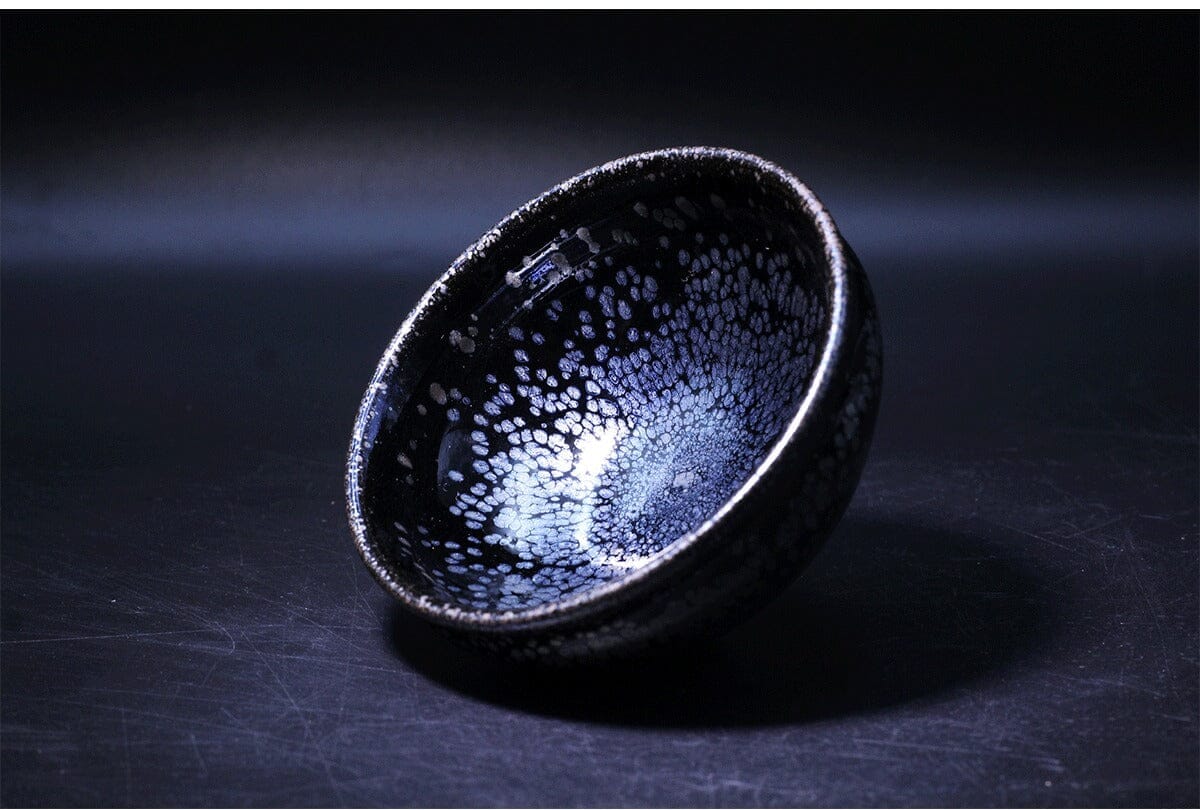As a representative of black porcelain and one of the eight famous Song Dynasty ceramics, the value of Jian bowls is determined by their natural kiln transformation and endless variations, which are loved by many tea drinkers and bowl enthusiasts.

If you want to talk about its most unique feature, nothing beats the unparalleled uniqueness of its patterns.
It is like raindrops left on a window.
It is like fish scales, both real and illusory.
It is like the fur of a rabbit, long and ever-changing, with indescribable beauty.
On an artistic level, we can generously evaluate it as follows,
But returning to the present, it seems that a more pressing question is what factors contribute to the vast difference in prices of Tenmoku?
Below, we will briefly analyze from these three dimensions:
- The basic pricing system of Tenmoku.
Generally, craftsmen who make Tenmoku have a set of pricing rules, which can be roughly divided into these two categories:
1: When the caliber and category of Tenmoku are the same, the price is uniform, and then the price fluctuates equally based on the size of the caliber.
2: When the caliber and category are the same, pricing is based on the different quality of the product.
- The relationship with the craftsman's professional title.
First of all, it should be noted that the higher the professional title of the Tenmoku craftsman, the higher the price is not necessarily.
Friends who know about the intangible cultural heritage industry may understand that the professional title of a craftsman is closely related to the price of their works.
However, this is not entirely true for Tenmoku, and the reasons are as follows:
1: The revival of Tenmoku has been relatively slow, and it has only received widespread attention in recent years.
In the early days, there were few professional title evaluations, and craftsmen had a hard time making a living.
2: The main price of Tenmoku still depends on the quality of the individual product, and the professional title is at most an added bonus..
However, going back to the point, many craftsmen with higher professional titles are indeed recognized as masters because of their excellent works.
PS: Therefore, it is highly recommended that when purchasing Tenmoku, one should first consider the quality and then inquire about the professional title. Only by understanding how to assess the quality of Tenmoku can one avoid being misled.
- The price is closely related to the quality.
1: From a craftsmanship perspective,
the forming process of Tenmoku includes: hand-pulled clay, machine-pressed clay, and semi-manual methods.
Therefore, normally speaking, the price of hand-pulled clay is higher than that of semi-manual, which is higher than that of machine-pressed clay.
2: The difference between firing Tenmoku in a wood-fired kiln, electric kiln, and gas kiln.
Wood firing is first and foremost prohibited by the government, and there is a shortage of pine supply. The cost is also quite high, and it takes several decades of successful experience to master. It is not something that anyone can do just because they want to.
Therefore, this results in the price of Tenmoku fired in a wood kiln being higher than that of Tenmoku fired in an electric or gas kiln.
However, the reduction atmosphere and temperature of an electric kiln also require precise manual control.
3: The patterns on the glaze.
Let's take the common patterns of "rabbit fur" and "oil droplets" as an example:
For the "rabbit fur" pattern, the longer the stripes, the better, and it is preferable for them to stretch from the rim to the base of the Tenmoku.
The distribution should not be too dense or too sparse, and it is preferable to have a sense of hierarchy and a three-dimensional effect.
For the "oil droplets" pattern, it is preferable to have varying sizes of droplets that are clear and visible. The spots should be evenly and fully distributed both inside and outside the Tenmoku.
Tenmoku that meets these standards will generally have higher prices.
- Rarity increases value.
Rarity can be considered from two aspects:
- The rarity of the patterns on the Tenmoku itself. If someone accidentally fires a Tenmoku with a rare "yao bian" pattern, then...
- This also relates to the Tenmoku craftsman. The higher the craftsman's seniority, the rarer their works are on the market, and it may be difficult to find similar works in the future. This goes without saying.









Share:
5 characteristics help understand the beauty of black porcelain's "mysterious darkness"
Analysis of 'Gong Yu' on Song Dynasty Tenmoku Cups: Five Perspectives